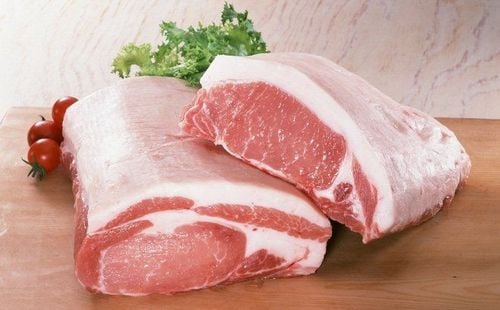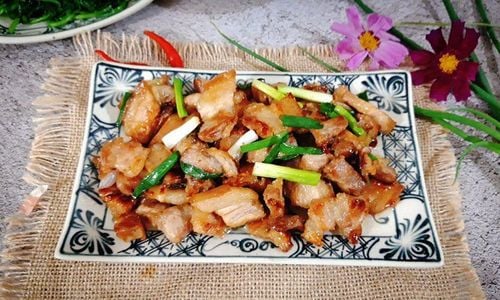This is an automatically translated article.
Pork is the most commonly consumed red meat worldwide. Its nutritional composition is especially rich in protein, essential amino acids, vitamins and minerals to help the body develop. These are the foods that should be chosen to complement a healthy diet.1. Protein content and other nutrients in pork
Pork is a food rich in protein and contains various fats. A serving of protein in 100 grams of cooked ground pork provides the following nutrients:Calories: 297 Water: 53% Protein: 25.7 grams Carbs: 0 grams Sugars: 0 grams Fiber: 0 grams Lipids : 20.8 grams
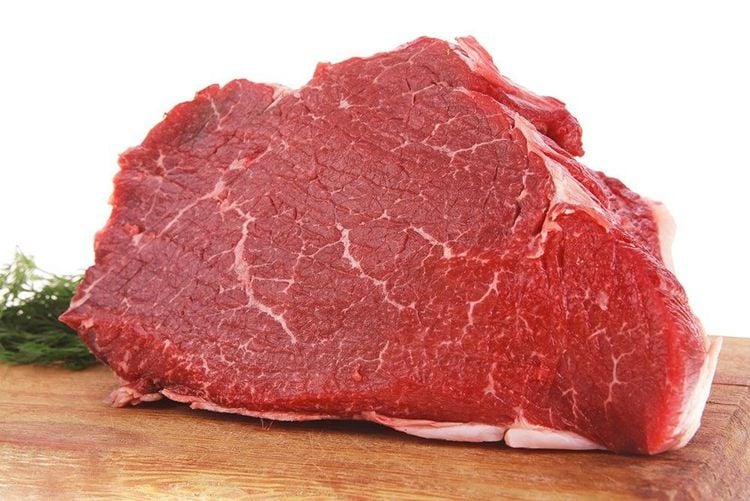
Thịt lợn là một loại thực phẩm giàu protein và chứa nhiều chất béo khác nhau
1.1. Protein in pork
Similar to all other meats, the nutritional composition of pork is mainly made up of protein. The protein content of lean pork when cooked is about 26% fresh weight.When dried, the protein content of lean pork can be as high as 89% - making it one of the richest food sources of protein. Furthermore, it contains all nine essential amino acids required for the body's growth and maintenance. In fact, meat is also one of the most complete sources of protein.
For this reason, eating pork or other meats can be especially beneficial for bodybuilders, recovering athletes, and those following surgery.
1.2. Other nutrients in pork
Lard:Pork contains various fats. The percentage of fat nutrients in pork usually ranges from 10 to 16%, but this percentage can be much higher depending on the fatness of the pig and other factors.
Similar to other red meats, pork fat is mainly composed of saturated fat and unsaturated fat present in approximately equal amounts.
Pork has a slightly different fatty acid nutritional profile than meat from ruminants, such as beef and lamb. Pork fat contains less CLA-conjugated linoleic acid and slightly more unsaturated fat.
Vitamins and minerals:
Pork is a rich source of vitamins and minerals, including:
Thiamine: Compared with other red meats, such as beef and lamb, pork is particularly rich in thiamin. One of the B vitamins that play an essential role of functioning in various functions in the body. Selenium: Pork is rich in selenium. The best food sources of this essential mineral are foods of animal origin, such as meat, seafood, eggs and dairy products. Zinc: An important mineral found in pork is zinc, which is necessary for a healthy brain and immune system. Vitamin B12. Found almost exclusively in foods of animal origin, vitamin B12 is important for blood formation and brain function. Vitamin B12 deficiency can cause anemia and damage to nerve cells. Vitamin B6: A group of related vitamins, vitamin B6 is important for the formation of red blood cells. Niacin: One of the B vitamins, niacin or vitamin B3 has many different functions in the body and is important for growth and metabolism. Phosphorus: Abundant and common in most foods, phosphorus is often a large component of people's diets. Phosphorus compounds in pork are essential for the growth and maintenance of the body. Iron: Pork contains less iron than lamb or beef. However, the process of absorbing ferromagnetic (heme-iron) from the digestive tract is very efficient, so pork can be considered a superior source of iron.
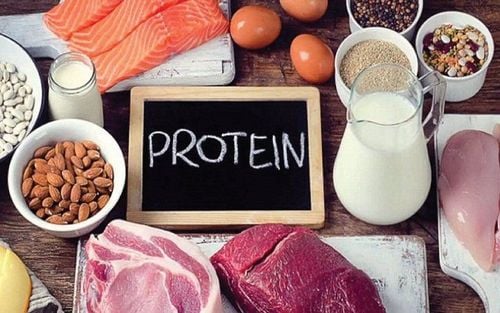
Khi ở dạng khô, hàm lượng protein trong thịt heo nạc có thể cao tới 89%
2. Health Benefits of Pork
Pork is a great source of healthy vitamins and minerals, as well as high-quality protein. Well-cooked pork can be a great part of a healthy diet. Therefore, consuming pork can bring some of the following health benefits:2.1. Maintain muscle mass
Similar to most foods of animal origin, pork is an excellent source of high-quality protein. With each person's age, maintaining muscle mass is an important issue for health. Without exercise and proper diet, muscle mass will naturally degrade as you age. This is an adverse change that is associated with many health problems and age.In some severe cases, muscle loss leads to a condition known as myasthenia gravis, characterized by very low muscle mass and reduced quality of life. Sarcopenia is a fairly common condition in older adults.
Inadequate intake of high-quality protein can accelerate age-related muscle degeneration while increasing the risk of myopathy.
Using pork or other high-protein foods is a great way to ensure that you are getting enough high-quality protein in your diet that can help maintain muscle mass.
2.2. Improve exercise performance
Eating meat is not only beneficial for maintaining muscle mass, but it can also improve muscle function and physical performance. Not only that, pork also contains many healthy nutrients that are beneficial for your muscles. These include taurine, creatine, and beta-alanine. Beta alanine is an amino acid that the body uses to produce carnosine, which is important for muscle function.In fact, high levels of carnosine in human muscles have been linked to reduced fatigue and improved physical performance. Therefore, following a vegetarian or vegan diet low in beta alanine reduces the amount of carnosine in muscle over time.
In contrast, a diet high in beta alanine including from dietary supplements increased carnosine levels in the muscle. Therefore, consuming pork or other food sources of beta alanine may be beneficial for people who want to maximize their physical performance.
2.3. Pork and heart disease
Heart disease is believed to be the main cause of premature death worldwide. The disease includes adverse health conditions such as heart attack, stroke and high blood pressure. Studies on the link between red meat and heart disease have shown mixed results.Several theories about the association between cholesterol and saturated fat in meat and an increased risk of heart disease. However, dietary cholesterol has little or no effect on cholesterol levels in most people, and many scientists do not consider this a health concern.
The link between saturated fat and heart disease is still controversial and some scientists have begun to downplay its role in heart disease.
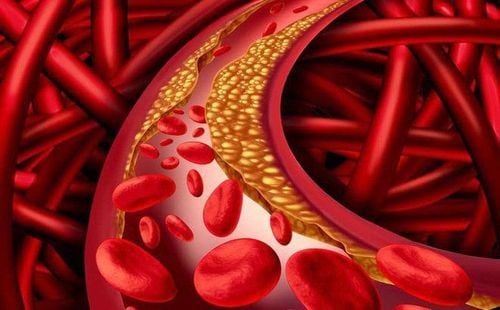
Có giả thuyết về hàm lượng cholesterol và chất béo bão hòa trong thịt làm tăng nguy cơ mắc bệnh tim
2.4. Pork and cancer
Cancer is a dangerous disease. It is characterized by uncontrolled growth of cells in the body. Previous studies have also observed a link between red meat and colon cancer risk. Even so, the grounds given are not entirely consistent.It is difficult to prove that pork causes cancer in humans because observational studies cannot provide evidence for a direct cause-and-effect relationship.
However, the idea that eating a lot of meat causes cancer is justifiable. This is the case with high-temperature meat processing. Overcooked meat may contain a number of carcinogens, most notably heterocyclic amines.
Heterocyclic amines are unhealthy substances found in relatively high amounts in cooked and overcooked meat, fish or other animal protein sources. These compounds are formed when animal proteins, such as pork, are exposed to very high temperatures during baking, grilling, grilling or frying.
Studies show that foods high in heterocyclic amines increase the risk of certain types of cancer, such as colon, breast, and prostate.
In the context of a healthy diet, eating moderately cooked pork may not increase cancer risk. However, to ensure optimal health, you should limit the processing and use of overcooked pork.
Please dial HOTLINE for more information or register for an appointment HERE. Download MyVinmec app to make appointments faster and to manage your bookings easily.
Reference sources: healthline.com, verywellfit.com




